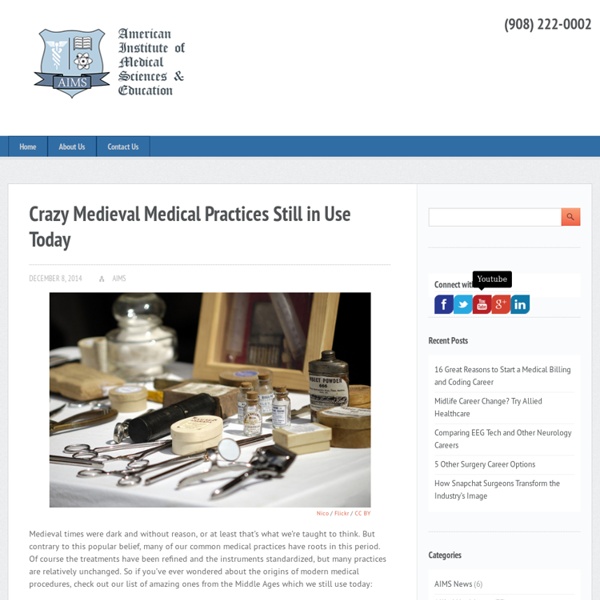Crazy Medieval Medical Practices We Still Use

Malleus Maleficarum
The Malleus Maleficarum[2] (commonly rendered into English as "Hammer of [the] Witches";[3] Der Hexenhammer in German) is a treatise on the prosecution of witches, written in 1486 by Heinrich Kramer, a German Catholic clergyman. The book was first published in Speyer, Germany, in 1487.[4] James Sprenger is also often attributed as an author, but some scholars now believe that he became associated with the Malleus Maleficarum largely as a result of Kramer's wish to lend his book as much official authority as possible.[5] The main purpose of the Malleus was to systematically refute arguments claiming that witchcraft does not exist, to discredit those who expressed skepticism about its reality, to claim that those who practised witchcraft were more often women than men, and to educate magistrates on the procedures that could find them out and convict them. Background[edit] In 1484 Heinrich Kramer had made one of the first attempts at prosecuting alleged witches in the Tyrol region. Notes
Bloodletting
Ancient Greek painting on a vase, showing a physician (iatros) bleeding a patient Bloodletting (or blood-letting) is the withdrawal of blood from a patient to cure or prevent illness and disease. Bloodletting was based on an ancient system of medicine in which blood and other bodily fluids were regarded as "humors" that had to remain in proper balance to maintain health. In the ancient world[edit] A chart showing the parts of the body to be bled for different diseases, c.1310-1320 "Bleeding" a patient to health was modeled on the process of menstruation. The Talmud recommended a specific day of the week and days of the month for bloodletting, and similar rules, though less codified, can be found among Christian writings advising which saints' days were favourable for bloodletting. Post 10th century[edit] Ioannis Sculteti, Armamentium Chirugiae, 1693 — Diagrammed transfusion of sheep's blood Scarificator, showing depth adjustment bar Diagram of scarificator, showing depth adjustment
10 Completely Uncanny Superstitions From The Middle Ages
Weird Stuff In the pre-scientific Middle Ages, the world was at the same time both fascinating and frightening. In the absence of proper knowledge, people had no choice but to fall back on their own imaginations to make sense of the myriad natural phenomena around them. The result was a world where everything seemed magical, a place teeming with angels and demons, fairies and goblins, elves, gnomes, and witches. 10 The Sea In The Sky For this story, we are indebted to English chronicler Gervase of Tilbury and his work Otia Imperiala. For proof, Gervase offers an episode that took place in an English village. Another tale concerns a merchant who accidentally dropped his knife while out at sea. 9 Omens Of Charlemagne’s Death The Frankish king Charlemagne was crowned Holy Roman Emperor in A.D. 800. During his last Saxon campaign against the Danes, Charlemagne himself saw a ball of fire appear and rush across the sky as he was leaving camp at sunrise. 8 Magonia 7 Changelings 6 The Royal Touch
Related:
Related:



